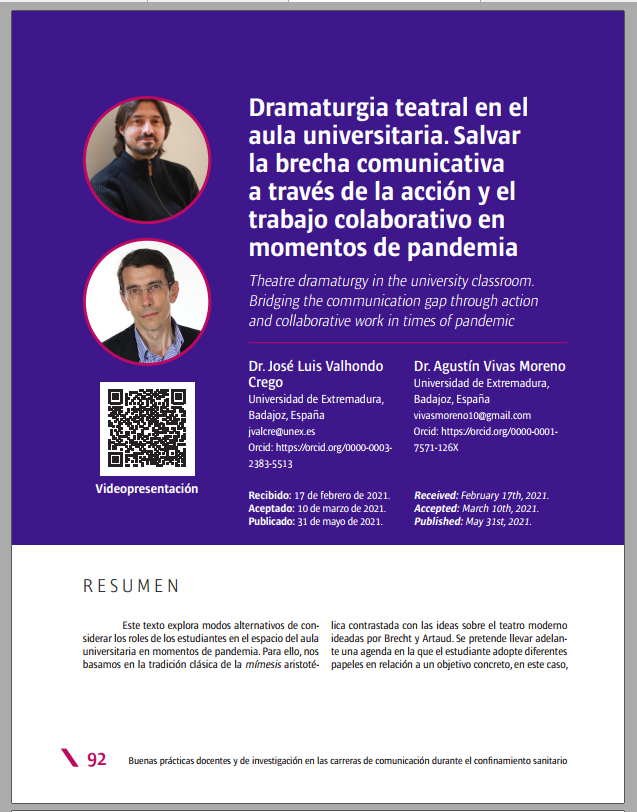Dramaturgia teatral en el aula universitaria. Salvar la brecha comunicativa a través de la acción y el trabajo colaborativo en momentos de pandemia
Contenido principal del artículo
Resumen
Este texto explora modos alternativos de considerar los roles de los estudiantes en el espacio del aula universitaria en momentos de pandemia. Para ello, nos basamos en la tradición clásica de la mímesis aristotélica contrastada con las ideas sobre el teatro moderno ideadas por Brecht y Artaud. Se pretende llevar adelante una agenda en la que el estudiante adopte diferentes papeles en relación a un objetivo concreto, en este caso, el de aprender a traducir imágenes a palabras y viceversa, en el entorno de la Narrativa Audiovisual. Se emplean los modelos consolidados del Aprendizaje Basado en Problemas (ABP) y el Aprendizaje Colaborativo (AC). El diseño propuesto se compone de una serie de fases en las que el rol del espectador va modificándose, desde la observación hasta la participación activa en la tarea.
Detalles del artículo
Sección

Esta obra está bajo una licencia internacional Creative Commons Atribución-NoComercial-SinDerivadas 4.0.
Cómo citar
Referencias
Bálint, K. y Kóvacs, András B. (2010). Focalization, attachment, and film viewers’ responses to film characters. En Reinhard, C. & Olson C. (Eds.) Making sense of Cinema: Empirical studies into film spectators and spectatorship. New York: Bloomsbury.
Crithcley, Simon (2020). La tragedia, los griegos y nosotros. Madrid. Noema.
Durkheim, Émile (1982 [1912]). Las formas elementales de la vida religiosa. Madrid, Alianza editorial.
Gamson, William (1992). Talking politics. Cambridge, Cambridge University Press.
Goffman, Erwin (1959). The Presentation of Self in Everyday Life. New York, Doubleday, Anchor Books.
Habermas, Jürgen (1989). Historia y crítica de la opinión pública. La transformación estructural de la vida pública. Barcelona, Gustavo Gili.
Rancière, Jacques (2010). El espectador emancipado. Buenos Aires, Manantial.

